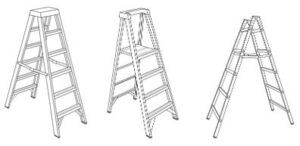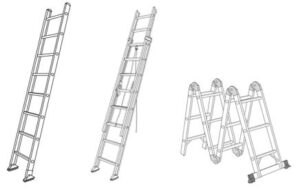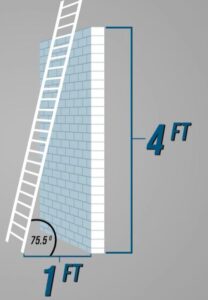
By Team Seaglass
Climbing with Confidence: Workplace Ladder Safety Best Practices
Ladders are essential tools for workplace maintenance, enabling safe access to elevated areas for repairs, inspections, and installations. However, improper ladder use can result in serious injuries, lost work time, and increased liability for employers. Ensuring proper ladder safety is critical to maintaining productivity and preventing accidents. Here’s a comprehensive guide to using ladders safely.
1. Select the Right Ladder for the Job: Using the correct ladder type can enhance safety and efficiency:
• Ladder Type: Choose an appropriate ladder, such as step ladders for indoor maintenance, extension ladders for high-reaching tasks, and platform ladders for stability during prolonged work.
o Self-Supporting Ladders: By design these ladders stand on their own without support from external structures- step ladders, double front ladders, podium & platform ladders, trestle ladders, articulating ladders in step-ladder mode.
o Non-Self-Supporting Ladders: Portable ladders must be placed against a structure independent of itself such as a wall for support- single lean ladders, extension ladders, sectional ladders, and articulating ladders set up in a stepladder mode
• Material Matters: Fiberglass ladders are strong, lightweight, and electrically non-conductive. Aluminum ladders are also lightweight, but CANNOT be used near electrical wiring.
• Load Capacity: Each ladder type has a load capacity rating based on the ladder type. There are 5 different load capacities, and each have their own label. Always check the label to be sure it will support the load:
• Height Considerations: Ensure the ladder is tall enough to reach the work area without standing on the top two rungs.
2. Inspect the Ladder Before Use: Routine inspections help prevent workplace injuries:
• Check for Damage: Look for cracks, loose steps, bent rails or rungs that could compromise safety.
• Ensure Cleanliness: Remove oil, grease, or debris to prevent slips.
• Verify Stability: Confirm that all locking mechanisms and feet are secure before use.
• Evidence of Damage: If a ladder doesn’t pass inspection, they cannot be “fixed”, as they lose their integrity when damaged. All damaged ladders should be removed from the workplace and destroyed so they cannot be inadvertently used by others.
3. Set Up the Ladder Properly: Correct positioning reduces workplace hazards:
• Manufacturer’s Instructions: Always review manufacturer’s instructions to ensure proper ladder use and set-up, as different ladder types and manufacturer’s guidelines may vary.
• Stable Ground: Place ladders on firm, level surfaces and use anti-slip feet or mats if necessary. Never set ladders on other structures.
• Proper Angle: Set non-self-supporting ladders at a 75-degree angle (one foot out for every four feet of height from the roof edge, not the wall).
• Ladder Height: A minimum 3 ft. extension is required at the upper landing, and no weight should be located on those rungs.
• Secure Placement: Lock spreaders on step ladders and use ladder stabilizers for non-self-supporting ladders for additional securement.
• Be Aware of Surroundings: Avoid placing ladders near power lines or doorways with heavy foot traffic.
• Avoid Hazardous Conditions: Do not use ladders in high winds, rain, or icy conditions.
4. Safe Climbing and Working Practices: Following proper climbing techniques minimizes accident risks:
• Check Load Limits: Never exceed the maximum weight capacity, including tools and materials.
• Wear Appropriate Footwear: Use slip-resistant, closed-toe shoes for better grip.
• Maintain Three Points of Contact: Always have two hands and one foot or two feet and one hand on the ladder.
• Face the Ladder: Climb and descend slowly while keeping your body centered between the rails.
• Avoid Overreaching: Move the ladder instead of stretching beyond its sides to maintain balance.
• Ladder Securement: Be sure ladder is secured. Never move the ladder while on it, and don’t push/pull objects while on the ladder.
• Step with Caution: Use deliberate movements and don’t skip rungs when ascending/descending the ladder. Never step on the top 2 rungs of a ladder.
5. Utilize Safety Accessories: Enhancing ladder stability with additional equipment improves workplace safety:
• Ladder Stabilizers and Wall Mounts: These devices provide extra balance, especially on uneven or fragile surfaces.
• Leveling Devices: Adjust for uneven terrain to maintain a stable setup.
• Tie-offs and Ladder Extensions: Always secure the ladder at the top and consider ladder extension arms to permit safer entry to the work platform
• Safety Harnesses: Essential for high-risk jobs, reducing the risk of falls from significant heights.
6. Proper Ladder Storage and Maintenance: Keeping ladders in good condition extends their lifespan and ensures reliability:
• Store Correctly: Keep ladders in a dry, temperature-controlled environment to prevent warping or corrosion. Non-self-supporting ladders should be stored in flat racks to reduce sagging. Self- supporting ladders can be stored vertically.
• Weather Impact: Don’t leave them outside- weather can negatively affect the integrity of the ladder.
• Regular Maintenance: Schedule routine checks for wear and tear, and replace damaged ladders immediately. Ladders should be tagged for evidence of inspection routine.
Refer to the NIOSH Ladder Safety App for further guidance.
Workplace ladder safety is not just about compliance—it’s about protecting employees, reducing risks, and improving efficiency. By selecting the right ladder, conducting regular inspections, setting up properly, and following safety guidelines, businesses can minimize workplace injuries and promote a safer working environment.
Stay safe, follow best practices, and climb with confidence!




